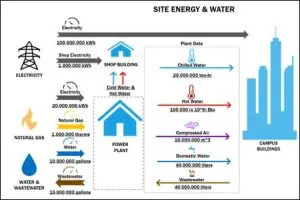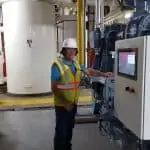

Energy audits and energy program management can significantly help as energy costs rise. Depending upon where you live, you may have witnessed a 5% increase to a staggering 15% increase in your electricity bills. According to the U.S. Energy Information Administration, the average retail price of one kilowatt-hour of electricity in the U.S. rose 6.5%, to 16.5 cents (17.5 cents for residential May 2024 to May 2025), over the last year. Some states have been hit especially hard: ratepayers in Maine experienced price increases of 36% last year, followed by Connecticut at 18% and Utah at 15%. [EIA]
Efficiency is always in season, but perhaps never quite as much as when it impacts your bank account. Energy efficiency is unique because it presents the co-benefit of reducing greenhouse gas (GHG) emissions along with energy costs. A client recently selected SCS Engineers in search of just that: the co-benefit of reduced energy costs and GHG emissions. SCS performed energy audits across the client’s portfolio. The first thing that may come to mind when you think of energy audits are the specific measures you take to save energy: 1) turning off the lights, 2) installing a newer, more efficient air conditioner, 3) adjusting the temperature warmer in the summer/cooler in the winter, or 4) replacing lighting with more efficient LED lamps or fixtures.
An energy audit (performed to the American Society of Heating, Refrigeration and Air-Conditioning Engineers (ASHRAE) level II standards), however, does far more than identify individual energy conservation measures (ECMs) or places where energy is wasted. The process requires a review of the historic energy usage or utility bills (usually 12 – 36 months) to establish a baseline, energy use patterns, to aid in identifying possible anomalies or discrepancies.
During the audit process, we found that the client wasn’t tracking historical energy utilization trends. Due to the number of facilities (more than 200), monthly reconciliation of electric bills was challenging without an Electronic Data Interchange (EDI) with the utility, and they did not have a comprehensive list of monthly charges that corresponded to their portfolio of properties. The client’s organization included a different department responsible for reviewing energy utilization and costs and a separate department responsible for maintenance and operations, with limited collaboration. At other properties, third-party management companies were responsible for utilities as well as maintenance and operations.
Where to Start?
As the saying goes, “you can’t manage what you can’t measure”. Or to use an analogy, if you want to lose weight, you need to step on the scale. Stepping on that scale and measuring your weight allows you to know where you are starting from – your baseline. The same is true for saving energy. If you want to save energy (and money!) while reducing your environmental footprint, you need to understand what you are currently using and spending. That information comes from the utility billing data referenced earlier. A good understanding and accurate tracking of monthly billing data is necessary for a successful energy management program. Once the data is obtained, it must be calendar and weather-normalized.
Benchmarking – Once you review your baseline data and are satisfied with the quality, published data allows you to compare your facility’s energy performance against similar buildings based on occupancy use type, for example. This information is becoming more readily accessible than in years past. A growing trend in climate-focused regions requires this review under local ordinances and regulations known as Building Performance Standards (BPS), which we will discuss later. Who knows, your facility may already be “best in class” compared with similar facilities, allowing you to focus your “energy” elsewhere. If you aren’t so fortunate, an energy audit performed by qualified professionals may be an appropriate next step.
How Energy Audits Impact Operations
One significant finding from the audits was the impact of proper maintenance on energy usage and building performance. Using another analogy, “Maintaining equipment is like keeping your car’s tires properly inflated.” If the tires are inflated to the right pressure (well-maintained system), the car rolls smoothly, fuel economy is good, and parts wear evenly. If the tires are low (dirty filters, worn belts, misaligned dampers), the engine must work harder to go the same distance—fuel use goes up, wear increases, and performance drops. Just as a vehicle’s preventative maintenance saves fuel, regular building and equipment maintenance saves energy and extends equipment life. Studies by the U.S. Department of Energy show that preventative maintenance programs can lead to 12-18% in energy savings (Unlock Hidden Savings: How Preventive Maintenance Boosts Your Bottom Line by 12-18%).
For one client, the audit revealed that a significant amount of major mechanical equipment (HVAC) was approaching the end of its useful life, and preventative maintenance activities were inadequate to extend equipment life and provide energy efficiency. Typical cost paybacks for preventative programs are often immediate, within 1 – 2 years. Preventive maintenance is especially important when working with critical or major equipment. Being reactive will generally cost you 2 – 3 times more than scheduled work for emergency repairs due to after-hours labor, expedited parts and shipping, and business disruption, not to mention potential impacts on occupant comfort and productivity.
Energy Conservation Measures
Perhaps the issues described sound all too familiar. Study after study reveals that many portfolio managers/owners commonly struggle with challenges such as limited resources, financial constraints, account management, limited energy expertise, information overload, and staff turnover. The good news is that an energy audit can provide a clear roadmap and achievable steps to improve energy efficiency and lower costs. Many of the Energy Conservation Measures (ECMs) that our energy professionals identified from this particular audit were either “no-cost” or “low-cost” to implement. Examples of no-cost or low-cost ECMs include power management of office equipment, adding or upgrading controls (such as thermostats), retro-commissioning mechanical equipment, and improving preventative maintenance to save significant costs.
In addition to no-cost or low-cost measures, some ECMs require capital investment. Capital improvements generally involve major building systems such as the HVAC, lighting, and building envelope, and should be prioritized based on Return On Investment (ROI). It’s also recommended to coordinate with maintenance and operations on major equipment at the end of life, plan for its replacement, and consider features from newer technology that will improve energy efficiency. Equipment replacement alone may not offer an ROI, but the energy performance and features you can upgrade can provide an ROI.
Educating Consumers and Employees
Education and outreach are important considerations as occupant behavior has a larger impact than you might imagine. A study by the U.S. EPA revealed that building occupants contribute up to 30% of a building’s energy consumption (8 Great Strategies to Engage Tenants on Energy Efficiency). Recognizing the impact of building occupants on energy consumption, educating and engaging occupants on the importance and benefits of energy conservation can be one of the most effective low-cost measures to implement. It is important to recognize that energy efficiency education isn’t a one-time effort but a continuing practice that evolves and increases. Education and outreach programs vary depending on the type of facility and often include ‘dashboards’ displaying energy use and cost information, flyers and brochures, competitions, energy awareness campaigns, nominations, and rewards for the best submitted energy reduction concept or regular energy saving results as measured by the energy bills. Messaging may span a variety of formats, including newsletters, videos, posters, workshops, webinars, or even social media posts.
Getting the Most Return
An effective and successful energy management program includes more than an energy audit. A strong energy management program includes ongoing monitoring of energy bills and utilization, occasional benchmarking, collaborating with operations and maintenance, occupant education and outreach, and future planning for capital needs, including energy efficiency features that offer a return on investment. And while you are at it, be sure to quantify the energy and cost savings, celebrate, and share the sustainable co-benefits your energy reduction efforts produce.

Energy costs are becoming more important to your bottom line due to inflation, energy shortages/increased global demand, tightening environmental regulations, growing corporate sustainability goals, and climate change challenges. Those companies with an effective energy management program that have reduced energy costs and reinvested savings in new energy projects could have a considerable competitive advantage.
An energy management program supported by owners, management, operators, and staff is more likely to select efficient choices that minimize life-cycle cost, provide a return on investment (ROI), and maximize profits. SCS has mechanical, electrical, industrial, and environmental energy professionals nationwide who understand how to achieve more efficient production using electricity, conventional/renewable fuels, and water in industries.
Specifically, SCS has over 100 years of cumulative ammonia refrigeration experience regarding operations, design, maintenance, compliance, energy audits, commissioning and retro-commissioning, system assessments, energy modeling, equipment selection, and control systems.
The following steps illustrate a tiered approach to energy management for ammonia refrigeration facilities:
Onsite Energy Audit
SCS professionals with decades of experience working with refrigeration and energy-consuming systems conduct the onsite audit. The visit includes working with the facility staff to evaluate day-to-day operations; learn about the state of equipment and plans for changes; obtain energy use and utility cost data; gain insight into energy demands and controls systems; and conduct a plant walkthrough. During the walkthrough, SCS may use portable data loggers, infrared thermal imaging, or other tools to supplement staff knowledge to help quantify energy conservation measures.
Findings Report
The main deliverable of the onsite audit is the audit report. SCS provides a detailed audit report with our findings, observations, and possible system modifications. These could include but are not limited to pressure adjustments, equipment additions/alterations, control systems, operation schedule modifications, etc.
Engineering Report
Follow-up steps may involve detailed engineering recommendations for implementation. These can include evaluating and selecting alternative equipment, systems, and controls; calculating future energy consumption, costs, and savings; and checking to verify that changes do not create negative side effects.
Training
SCS supports the implementation phase of the findings by providing operator training. Training is key ─ operators then understand what changes to expect and why. Operator “buy-in” is a key element for the long-term sustainability of energy management programs.
Rebates & Incentives
To improve a project’s ROI, facility personnel should take advantage of local and federal incentives. SCS can help coordinate with the local utility to determine if the facility can use rebate programs and provide calculations to support estimated energy savings.

SCS helps our clients make sustainable energy management plans and sound investment decisions based on objective energy audits, assessments, and energy modeling. If you’d like to learn more about our facility energy management capabilities, visit our website or contact us at .
About our Authors:

